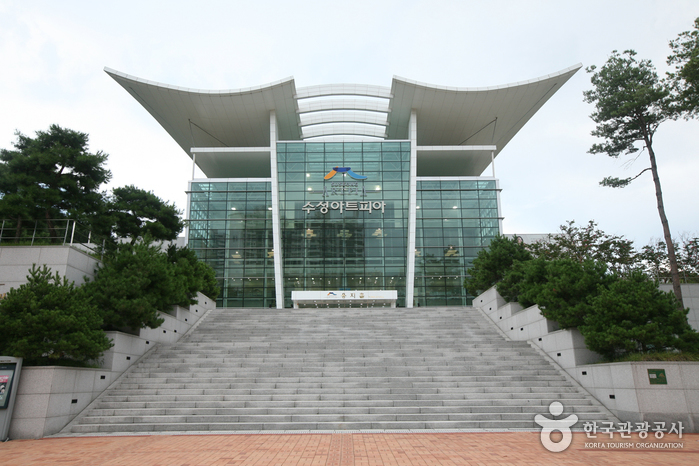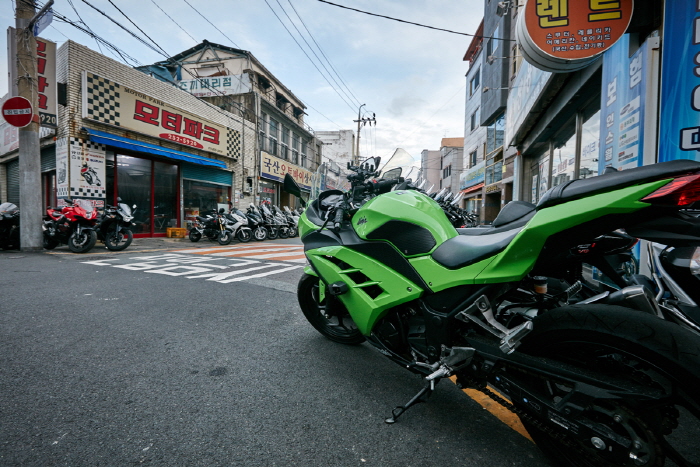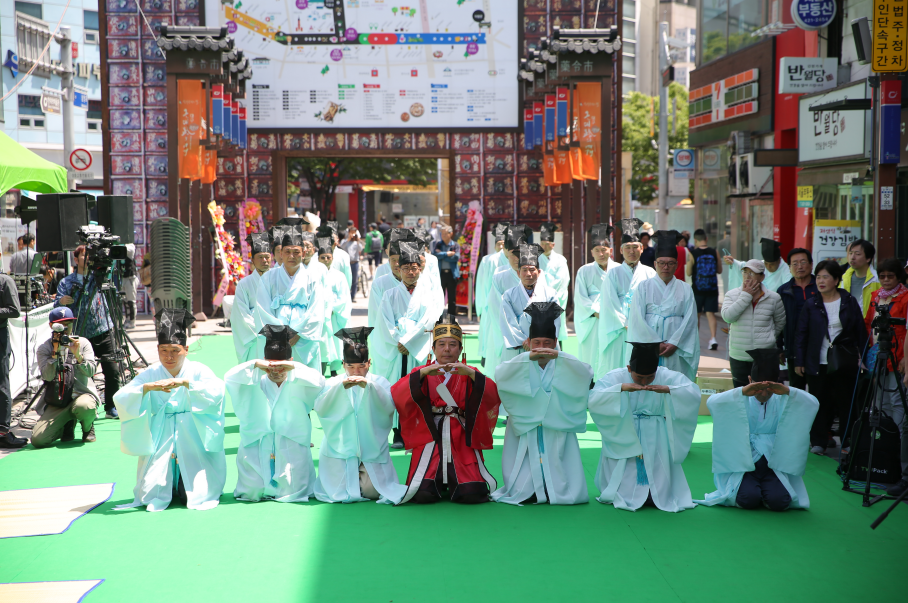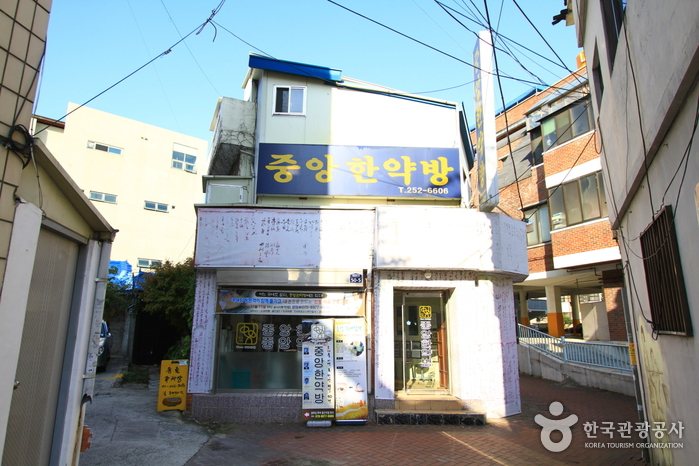Suseong Artpia (수성아트피아)
10.6 Km 26822 2021-04-09
180, Muhak-ro, Suseong-gu, Daegu
+82-53-668-1800
Suseong Artpia, opened in May 2007, is a major art center in Daegu. It has specialized, independent spaces for housing performances, exhibitions, and art camps. The art center’s facade was designed to resemble a crane flying away with its wings stretched out in order to promote the image of Muhaksan Mountain (named as such because its shape is reminiscent of a flying crane or hak), the mountain on which the center is located. When viewed from the sides however, the center is shaped like a ship, as it was once the site of a large pond. With such an impressive exterior further highlighted by impressive lighting at night, water fountains, and landscaping, Suseong Artpia has become a rising attraction of Daegu. The center is equipped with a mega concert hall that can accommodate diverse genres of performing arts such as an opera, musical, ballet, theater, dance, music concert, and more.
Daegu Medicinal Herb Wholesale Market (대구 한약재 도매시장)
10.6 Km 0 2021-06-01
51-1, Namseong-ro, Jung-gu, Daegu
+82-53-257-0545
Daegu Medicinal Herb Wholesale Market, also known as Daegu Yangnyeongsi, is a major herbal medicine market specializing in the practices of Oriental medicine. The market dates all the way back to the Joseon dynasty, when the governor of Gyeongsang-do at that time supplied the best medicinal herbs to the central administrative office and sold the rest to the commoners. Among the many cities that served as suppliers of herbal medicine, Daegu survived as the longest and remained the most active. Until 1910, Daegu was at the center of the herbal medicine world, providing Oriental medicine to travelers from all around the world including Japan, China, Russia, Manchuria and many other countries. Even to this day, Daegu Yangnyeongsi continues to supply herbal medicine across the country and preserve the traditional medicine culture that has been passed down for over 350 years.
Daegu Motorcycle Street (대구 오토바이골목)
10.6 Km 18656 2021-02-09
Ingyo-dong, Jung-gu, Daegu
+82-53-627-1337
Daegu Motorcycle Street is located in Ingyo-dong, Jung-gu, Daegu along Sijangbuk-ro. The street was originally a creek lined with houses, but in 1953 the creek was covered over and made into a paved road. Gas stations and stores selling automotive parts sprung up, turning the area into a thriving commercial district. In 1961, the first motorcycle store opened its doors and was quickly followed by several more.
Currently there are 40 motorcycle stores, making this 200-meter-long street one of Daegu’s most unique shopping areas. Shoppers can find a vast array of new and secondhand motorcycles both domestic and imported, as well as a wide selection of motorcycle parts and accessories.
Daegu Yangnyeongsi Herbal Medicine Festival (대구약령시한방문화축제)
10.6 Km 26724 2024-04-25
51-1 Namseong-ro, Jung-gu, Daegu
+82-53-253-4729
The Daegu Yangnyeongsi Herbal Medicine Festival celebrates the herb medicine market in Daegu which has been operating since the Joseon dynasty. The festival takes place every year in May and gives visitors an opportunity to experience a wide range of relaxing and curative traditional medicinal procedures.
Petite Joongang Family Museum (작은 중앙가족박물관(한방개인박물관))
10.7 Km 10445 2021-12-20
50-5, Jungang-daero 77-gil, Jung-gu, Daegu
+82-53-252-6606
Petite Joongang Family Museum is a family-owned museum that showcases the antiquities of Oriental medicine, as practiced by a local family for three generations over 90 years in the city of Daegu, a city known for its 350-year-old medicinal herb market. The tools used by the family including scales, medicine bowls, prescriptions and manuscripts of traditional medicine tell the history of Oriental medicine in Korea as well as the family's dedication to treatment using the traditional herbal medicine practice. The museum serves its visitors with healthy Oriental medicine tea, while the living family members offer free medical consultation.
Saint James - Dongseong-ro Branch [Tax Refund Shop] (세인트제임스 동성로)
10.7 Km 0 2024-04-18
1F, and 2F, 10, Dongseong-ro 1-gil, Jung-gu, Daegu
-
Olive Young - Daegu Dongseong-ro Square Branch [Tax Refund Shop] (올리브영 대구동성로광장점)
10.7 Km 0 2024-06-27
1F, 28, Dongseong-ro 1-gil, Jung-gu, Daegu
-
Goun Skin Clinic [Tax Refund Shop] (고운피부과)
10.7 Km 0 2024-06-27
2127, Dalgubeol-daero, Jung-gu, Daegu
-
EW Folder - Dongseong-ro Samdeok Branch [Tax Refund Shop] (EW 폴더 동성로삼덕)
10.7 Km 0 2024-04-23
1F, 15, Dongseong-ro 1-gil, Jung-gu, Daegu
-
Daegu Korean Chinese Association (대구화교협회)
10.7 Km 0 2023-02-03
34, Jong-ro, Jung-gu, Daegu
+82-53-661-2624
Daegu Korean Chinese Association building is a red brick two-story Western-style house built in 1929. Seo Byeong-guk, a rich man in Daegu, entrusted the design and construction to Mo Mungeum, a Chinese architect. It is a flat rectangular structure, and the protruding granite porch balances left and right symmetry. There is a theory that the bricks were brought from Pyeongyang and the woods from Geumgangsan Mountain. It was also used as an HID (Headquarters of Intelligence Detachment) building. There is one building, a playground, a statue of Chiang Kai-shek, and a mural of a Chinese figure painted at the entrance. It is a representative modern building in the Daegu area that boasts a beautiful appearance and is currently used as the office of the Daegu Korean Chinese Association. It was designated as a National Registered Cultural Heritage on June 19, 2006, as it shows the style of modern architecture in the 1930s, not many examples of which are left. This is the last stop of Daegu Modern Alley Tour Course 2.





![Saint James - Dongseong-ro Branch [Tax Refund Shop] (세인트제임스 동성로)](http://tong.visitkorea.or.kr/cms/resource/03/2884103_image2_1.jpg)
![Goun Skin Clinic [Tax Refund Shop] (고운피부과)](http://tong.visitkorea.or.kr/cms/resource/00/3314000_image2_1.jpg)
![EW Folder - Dongseong-ro Samdeok Branch [Tax Refund Shop] (EW 폴더 동성로삼덕)](http://tong.visitkorea.or.kr/cms/resource/04/2884104_image2_1.jpg)
 English
English
 한국어
한국어 日本語
日本語 中文(简体)
中文(简体) Deutsch
Deutsch Français
Français Español
Español Русский
Русский